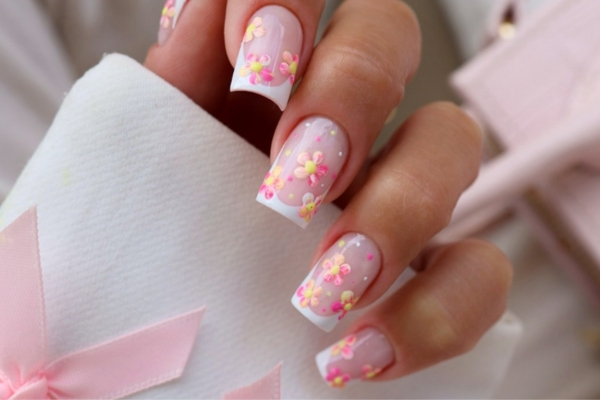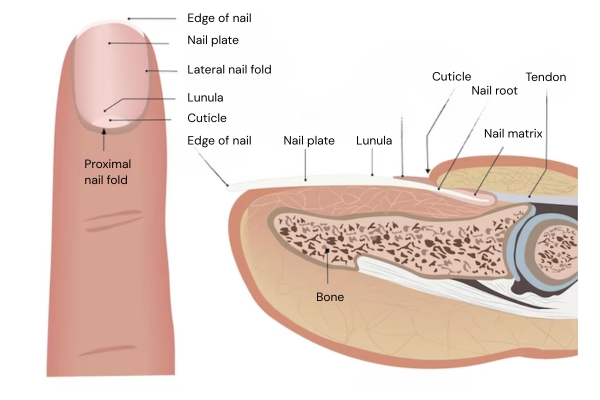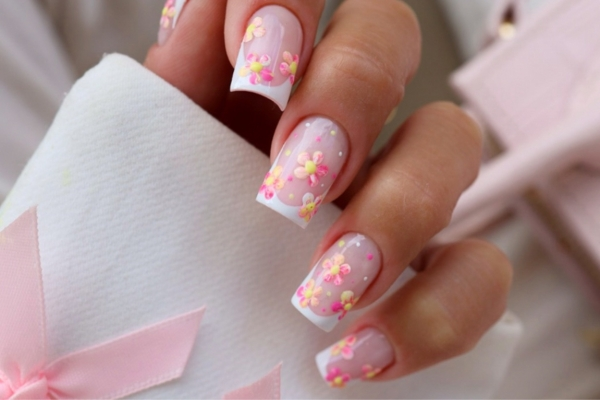Nail structure. Get to know your nails!

The nail may be small, but it plays a significant role. The structure of the nail includes several layers and components. Nails serve protective, aesthetic, and functional purposes in daily life. Moreover, their condition can tell you a lot about your health. What is a nail made of? What is the nail matrix? You'll find out in just a moment!
Nail structure – layers and components
Each of your nails is a system of layers working together to provide hardness, flexibility, and functionality. In addition to the nail plate, the entire structure includes several elements that play important roles in its growth and protection.
1. Nail plate – the first line of defense
This is the visible part of the nail. It’s transparent, and the pink hue comes from the nail bed underneath. The plate is made of dead keratin cells – it’s hard yet flexible.
2. Nail bed – the nutritional tissue
Located beneath the nail plate, it contains blood vessels that supply nutrients. Without it, nails wouldn’t grow healthily.
3. Nail matrix – where cells are created
New keratin cells form in the matrix, creating the nail plate. Any damage to the matrix can affect the nail’s shape and growth rate.
4. Lunula – the small crescent area
This is the white crescent-shaped area at the base of the nail. It’s responsible for active nail growth and is where new cells begin developing. It is the area you file with a nail file during a manicure.
5. Eponychium and hyponychium – protection and stability
The eponychium (cuticle) protects the matrix from bacteria. The hyponychium, under the free edge of the nail, helps prevent infections.
6. Nail fold – structural support
It stabilizes the nail and prevents it from shifting. It acts as a structural frame, increasing resistance to mechanical injury.

Silcare expert advice
The composition of the nail can vary, but typical values include:
- keratin – approx. 85–90%
- water – approx. 8–10%
- lipids – approx. 1–3%
- amino acids – approx. 2–3% (including cysteine)
- minerals – approx. 1–2% (calcium, magnesium, zinc, iron)
The role of nails in daily life
Nails protect fingertip pads from injury, and their appearance can signal health issues. Keep them in good condition using, for example, nail and cuticle oils.
Changes in nail appearance (spots, thickening, splitting) may indicate deficiencies, circulation problems, or skin conditions.
Silcare expert advice
The natural nail is the hard part of the finger that serves protective, aesthetic, and functional roles. It begins developing around the 8th week of fetal life and continues to grow throughout life, aiding in daily activities like grasping objects.
How to care for nails
Want healthy and strong nails? Here are a few tips:
1. Moisturize your nails
Use conditioners, oils, and butters to keep them in good shape.
2. Follow a nail-friendly diet
Include protein, zinc, iron, magnesium, and biotin – they support nail growth and health.
3. Avoid harsh chemicals
Limit nail contact with chemicals and water to avoid weakening their structure.
4. Protect from damage
Wear protective gloves during chores to reduce the risk of breaking nails.
5 most common nail problems
- Brittleness: often caused by deficiencies. Strengthening products, like Silcare conditioners, can help.
- Splitting: often the result of frequent soaking or exposure to harmful substances.
- Color changes: white spots may signal zinc deficiency; pale nails may indicate low iron. Consult a doctor.
- Fungal infections: yellow, brittle nails may be signs of fungal infection.
Want to avoid these problems? Choose Silcare products and care for your nails every day!
Recommended





